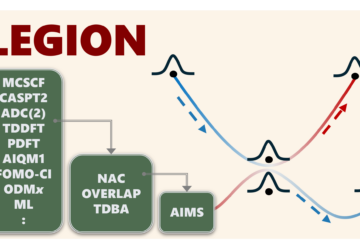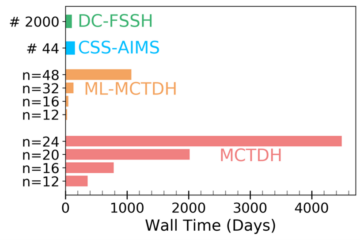Benchmark compares different ways to rescale velocities in surface hopping.
In brief:
- We compared different ways of rescaling the velocity after a hooping occurs, taking fulvene and PSB4 as molecular examples.
- Taking the nonadiabatic coupling vector direction as the reference, the best alternative is the gradient difference vector direction.
- If these vectors are unavailable, momentum direction with a reduced kinetic energy reservoir is recommended.
In surface hooping, nonadiabatic dynamics involving multiple electronic surfaces propagate independent trajectories on a single surface but allow it to change the surface during the dynamics based on a stochastic algorithm. This surface change, a hop, occurs through finite potential energy gaps. Thus, to ensure total energy conservation during dynamics, we must change the kinetic energy.
Semiclassical theory shows that the proper way to change the kinetic energy is by rescaling the nuclear velocities in the direction of the nonadiabatic coupling vector. Nevertheless, in many surface hopping variants, those vectors aren’t available. Then what’s the next best direction to rescale velocities?
Many researchers adopt the momentum direction. However, when that is done, an abnormal amount of back hopping can occur, leading to wrong nonadiabatic dynamics.
We investigated several velocity adjustment directions after shopping, assessing population decays and reaction yields of excited fulvene and a protonated Schiff base (PSB4).
We checked different sets of dynamics with the velocity adjusted either in the nonadiabatic coupling, gradient difference, or momentum directions. For the latter, besides the conventional algorithm, we investigated the performance of a reduced kinetic energy reservoir approach that we recently proposed. Our evaluation also considered velocity adjustment in the directions of approximate nonadiabatic coupling vectors.
The recommendations are the following:
- When nonadiabatic coupling vectors are unavailable, the gradient difference direction is the best adjustment option.
- If the gradient difference is also unavailable, the momentum direction with a reduced kinetic energy reservoir becomes an excellent option to prevent an artificial excess of back shopping.
The precise velocity adjustment direction is less crucial for describing the nonadiabatic dynamics than the kinetic energy reservoir’s size. Thus, the most important thing to consider is to reduce the amount of kinetic energy, especially in large molecular systems, to avoid artificial back hoppings.
MB
Reference
[1] J. M. Toldo, R. S. Mattos, M. Pinheiro, Jr., S. Mukherjee, M. Barbatti, Recommendations for Velocity Adjustment in Surface Hopping, J. Chem. Theory Comput. (2024). 10.1021/acs.jctc.3c01159




